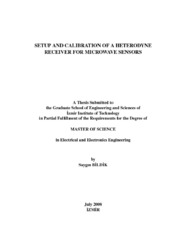Please use this identifier to cite or link to this item:
https://hdl.handle.net/11147/3960Full metadata record
| DC Field | Value | Language |
|---|---|---|
| dc.contributor.advisor | Aydınlık Bechteler, Ayşe Sevinç | - |
| dc.contributor.author | Bildik, Saygın | - |
| dc.date.accessioned | 2014-07-22T13:52:49Z | - |
| dc.date.available | 2014-07-22T13:52:49Z | - |
| dc.date.issued | 2008 | - |
| dc.identifier.uri | http://hdl.handle.net/11147/3960 | - |
| dc.description | Thesis (Master)--Izmir Institute of Technology, Electronics and Communication Engineering, Izmir, 2008 | en_US |
| dc.description | Includes bibliographical references (leaves: 72-73) | en_US |
| dc.description | Text in English; Abstract: Turkish and English | en_US |
| dc.description | iv, 73 leaves | en_US |
| dc.description.abstract | The demand for sensors for the measurement of various quantities has increased with the automatisation of industrial processes. In many cases microwave techniques provide competitive solutions. A large number of important applications are found such as dielectric constant measurement, moisture measurement, length measurement, leaking gas detection, radar applications, etc.Heterodyne receiver system is set up and calibrated to measure the resonant frequencies of resonator type sensors precisely and inexpensively. Output frequencies of the resonator type sensors are varied by the change in physical dimensions of the resonator or physical properties of a material placed in a resonator to be processed. Instead of the classical audio amplifier and a loudspeaker which are the elements of a classical heterodyne receiver, a frequency counter evaluates the signal. Thus, the heterodyne receiver used in frequency measurement system consists of a mixer, a voltage controlled oscillator, a microstrip line low-pass filter and a frequency counter. The output signal of the resonator is converted down to an intermediate frequency which is in the counting range of frequency counter via the mixer with VCO. Then, the measured data is sent to a computer and it is converted to the wanted data related to which measurement (distance, dielectric constant, etc.) is done and which resonator is used.In this study, distance measurement is performed by using a circular groove guide oscillator as a microwave sensor connected to the heterodyne receiver system. The most important feature of the groove guide oscillator is its resonator consists of physically two open parallel plates. Therefore, the resonant frequency of the oscillator can be changed depending on the distance between the two parallel plates. This makes the groove guide oscillator feasible for some applications like the distance measurement, using the resonant frequency measurement setup. | en_US |
| dc.language.iso | en | en_US |
| dc.publisher | Izmir Institute of Technology | en_US |
| dc.rights | info:eu-repo/semantics/openAccess | en_US |
| dc.subject.lcc | TK7876. B5953 2008 | en |
| dc.subject.lcsh | Microwae dedectors | en |
| dc.subject.lcsh | Heterodyning (Electronics) | en |
| dc.title | Setup and Calibration of a Heterodyne Receiver for Microwave Sensors | en_US |
| dc.type | Master Thesis | en_US |
| dc.institutionauthor | Bildik, Saygın | - |
| dc.department | Thesis (Master)--İzmir Institute of Technology, Electrical and Electronics Engineering | en_US |
| dc.relation.publicationcategory | Tez | en_US |
| dc.identifier.wosquality | N/A | - |
| dc.identifier.scopusquality | N/A | - |
| item.openairecristype | http://purl.org/coar/resource_type/c_18cf | - |
| item.languageiso639-1 | en | - |
| item.openairetype | Master Thesis | - |
| item.grantfulltext | open | - |
| item.fulltext | With Fulltext | - |
| item.cerifentitytype | Publications | - |
| Appears in Collections: | Master Degree / Yüksek Lisans Tezleri | |
Files in This Item:
| File | Description | Size | Format | |
|---|---|---|---|---|
| T000742.pdf | MasterThesis | 1.72 MB | Adobe PDF |  View/Open |
CORE Recommender
Page view(s)
42,526
checked on Mar 31, 2025
Download(s)
104
checked on Mar 31, 2025
Google ScholarTM
Check
Items in GCRIS Repository are protected by copyright, with all rights reserved, unless otherwise indicated.